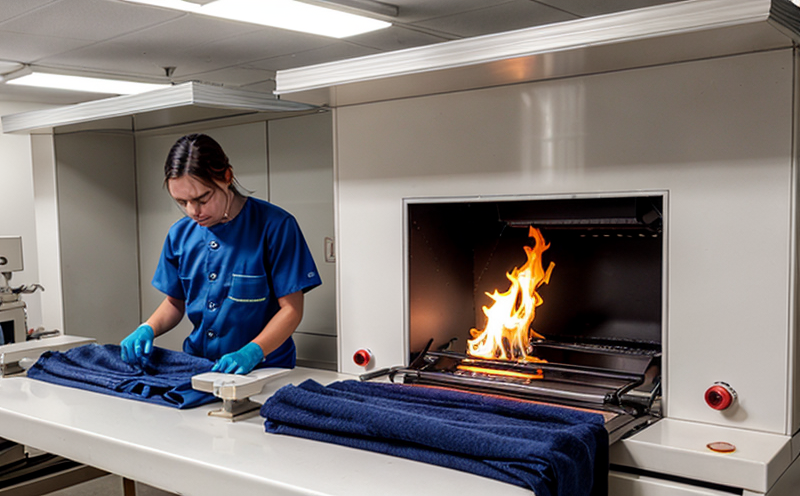Durability Assessment of Flame Retardant Apparel
Flame retardant textiles play a crucial role in ensuring safety during fire emergencies. The durability assessment of these materials is essential to ensure that the flame retardant properties remain effective over time, through wear and tear, washing cycles, and other environmental stresses. This service evaluates how well flame retardants withstand mechanical stress, chemical exposure, and repeated use. Understanding this aspect helps manufacturers make informed decisions about material selection and product design, ultimately enhancing fire safety standards.
During durability assessment testing, specimens undergo various simulated real-world conditions to mimic the kind of wear and tear they might experience in actual use. These tests involve mechanical abrasion, washing cycles with detergents, exposure to chemicals like alcohol or solvents, and repeated folding, among others. By subjecting flame retardant textiles to these rigorous conditions, we can assess their resistance to degradation that could compromise fire safety.
The testing methods used for durability assessment are based on international standards such as ISO 13935-2:2006 and ASTM D4835. These standards provide precise protocols for measuring the effectiveness of flame retardants under different stressors. The results from these tests not only inform manufacturers but also help regulatory bodies ensure compliance with fire safety regulations.
One key aspect of durability assessment is the ability to maintain flame resistance over time. Many flame retardant treatments can wear off or degrade, reducing their effectiveness. Through this service, we identify which treatments offer superior durability and longevity, enabling manufacturers to select materials that will retain their protective properties for longer periods.
Another important consideration in durability assessment is the impact on fabric performance. Some flame retardants may alter the texture or feel of textiles, affecting their overall quality. Our testing ensures that any changes are minimal and do not compromise the comfort or aesthetic appeal of the garment. This balance between safety and user experience is critical for developing successful products.
| Application | Description |
|---|---|
| Fabric for emergency response garments | Critical in ensuring that firefighters' protective clothing maintains its flame resistance over prolonged use. |
| Textiles used in public transport seats and upholstery | Ensuring safety in crowded environments where fire risks are higher. |
| Clothing for hazardous work environments | Protecting workers from accidental ignition sources. |
| Children's sleepwear and pajamas | Maintaining protection against potential fire hazards in sleeping areas. |
Scope and Methodology
The scope of durability assessment services includes evaluating the mechanical, chemical, and environmental resistance of flame retardant textiles. This involves a comprehensive approach that considers not just initial performance but also long-term effectiveness.
For mechanical stress testing, specimens are subjected to abrasive conditions mimicking real-world use, such as rubbing against rough surfaces or being repeatedly folded. These tests help determine how the fabric holds up under repeated wear and tear over time.
Chemical exposure tests assess the resilience of flame retardants when exposed to common household chemicals like alcohol or solvents that could potentially compromise their effectiveness. This is crucial for ensuring that garments remain safe even after being cleaned with typical detergents.
The final aspect involves evaluating the impact on fabric performance, including changes in texture, colorfastness, and overall quality. By measuring these factors, we ensure that durability assessments do not only focus on fire safety but also maintain product integrity and customer satisfaction.
Why Choose This Test
- Ensures compliance with international fire safety standards such as ISO 13935-2:2006 and ASTM D4835.
- Identifies flame retardant treatments that offer superior durability and longevity.
- Maintains fabric performance over time, balancing safety with comfort and aesthetics.
- Provides insights into the impact of repeated washing cycles on flame retardant effectiveness.
- Evaluates the resilience of fabrics under mechanical stress to ensure they retain their protective properties.
- Assists in selecting materials that meet strict fire safety regulations without compromising product quality.





